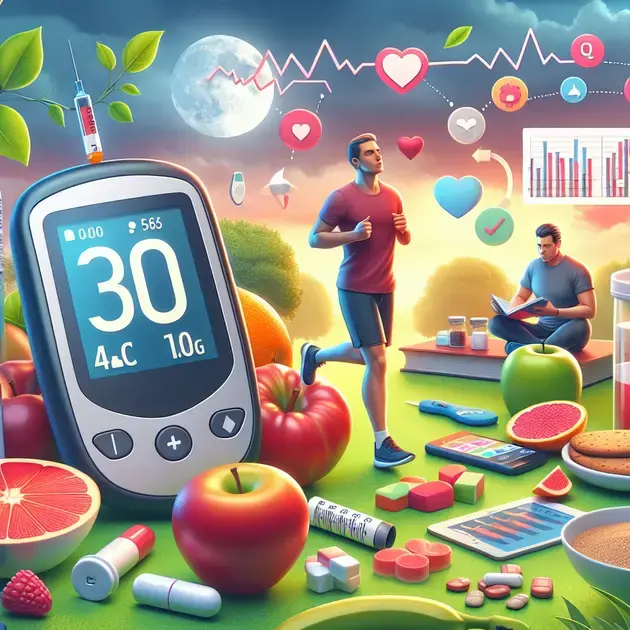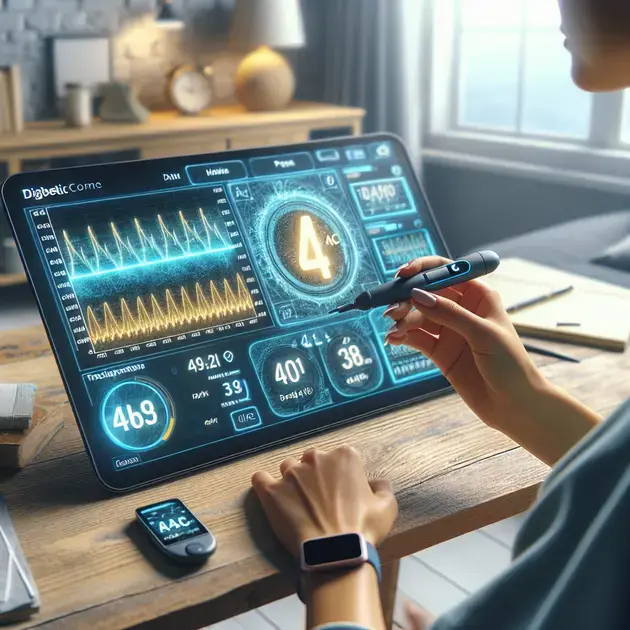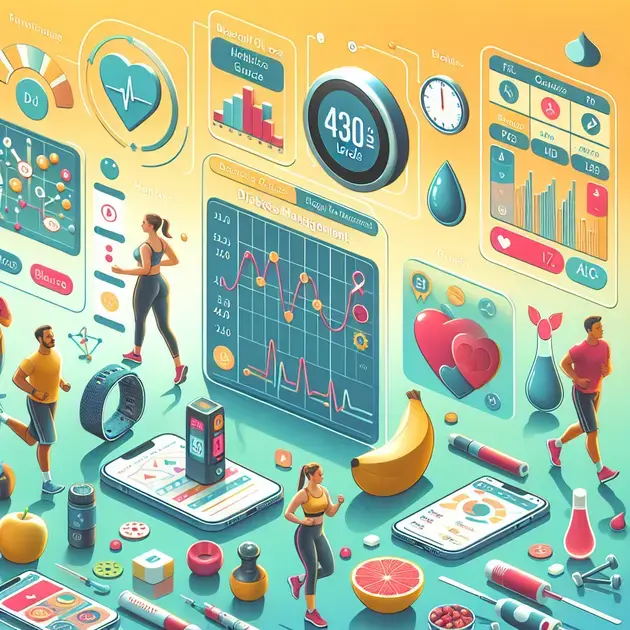Is HBA1c Average Glucose Reliable for Diagnosing Diabetes?
Understanding the link between HBA1c average glucose levels and diabetes diagnosis is crucial for proper management. But is this widely-used marker truly reliable? Join us as we delve into the intricacies of HBA1c tests and their implications in diagnosing diabetes accurately. Stay informed and empowered in your health journey with the latest insights on this critical health topic.

**Understanding the Relationship Between HBA1c and Average Glucose Levels**
The Importance of HBA1c Levels
Understanding the relationship between HBA1c and average glucose levels is crucial in managing diabetes. HBA1c, also known as glycated hemoglobin, provides insight into a person’s average blood glucose levels over the past 2-3 months. By measuring HBA1c, healthcare providers can assess how well diabetes is being controlled.
Using the MySugr App for Tracking HBA1c Levels
One helpful tool for tracking HBA1c levels is the MySugr app. This app allows users to log their blood sugar readings, medications, and meals. Additionally, MySugr provides a feature to track HBA1c levels over time, giving individuals a clear picture of their diabetes management.
Interpreting HBA1c Results
Typically, HBA1c levels below 5.7% are considered normal, while levels between 5.7% and 6.4% indicate prediabetes. A level of 6.5% or higher suggests diabetes. Understanding these ranges is essential for individuals to monitor and manage their condition effectively.
Personalizing Diabetes Management
Knowing the relationship between HBA1c and average glucose levels enables individuals to tailor their treatment plans. By working closely with healthcare providers and utilizing tools like the MySugr app, individuals can make informed decisions to maintain optimal blood sugar control.
Seeking Professional Guidance
For a comprehensive understanding of the relationship between HBA1c and average glucose levels, it is essential to consult with a healthcare provider. Regular monitoring, combined with professional advice, can significantly impact diabetes management and overall health.
**Analyzing the Accuracy of HBA1c in Diabetes Diagnosis**
Role of HBA1c in Diabetes Diagnosis
HBA1c plays a critical role in diagnosing diabetes as it provides a long-term view of blood glucose levels. However, analyzing the accuracy of HBA1c in diagnosis requires considering various factors beyond just the test result.
Using the ADA Guidelines for Diagnosis
Following the American Diabetes Association (ADA) guidelines is essential in accurately diagnosing diabetes using HBA1c levels. These guidelines outline specific criteria for interpreting HBA1c results and differentiating between prediabetes and diabetes.
Challenges in HBA1c Accuracy
While HBA1c is a valuable diagnostic tool, certain factors can affect its accuracy. Conditions such as anemia, kidney disease, and pregnancy can influence HBA1c results, leading to potential misdiagnosis if not carefully considered.
Confirmatory Testing for Accuracy
To ensure the accuracy of a diabetes diagnosis based on HBA1c levels, healthcare providers may recommend additional confirmatory tests. These tests, such as fasting plasma glucose or oral glucose tolerance tests, offer a more comprehensive assessment of an individual’s glucose metabolism.
Importance of Clinical Evaluation
Interpreting HBA1c results accurately requires a holistic approach that includes clinical evaluation and individualized patient assessment. Healthcare providers play a crucial role in analyzing HBA1c values within the context of a patient’s overall health and medical history.
Continual Monitoring and Adjustment
Regular monitoring of HBA1c levels and collaborating closely with healthcare professionals are vital in ensuring the accuracy of diabetes diagnosis and treatment. By staying proactive and responsive to changes, individuals can better manage their condition and overall well-being.
**Exploring the Limitations of Using HBA1c for Diagnosing Diabetes**
Understanding the Challenges of HBA1c Diagnosis
While HBA1c is a valuable indicator of long-term glucose control, it does have limitations when used as the sole diagnostic tool for diabetes. Exploring these limitations is essential in comprehensively evaluating an individual’s metabolic health.
Variability in HBA1c Results
One limitation of using HBA1c for diabetes diagnosis is the variability in results. Factors like age, ethnicity, and certain medical conditions can impact HBA1c values, potentially leading to misinterpretation and misdiagnosis.
Individual Differences in Glycation
Another challenge is the individual variability in the rate of hemoglobin glycation. Some individuals may have faster or slower glycation rates, affecting the accuracy of HBA1c results and complicating the diagnostic process.
Limitations in Specific Populations
Certain populations, such as older adults or individuals with specific health conditions, may present challenges in using HBA1c for diagnosis. In such cases, healthcare providers may need to consider alternative testing methods to ensure accurate diagnosis and treatment.
Complementary Diagnostic Tools
Recognizing the limitations of HBA1c, healthcare providers often integrate other diagnostic tools, such as fasting glucose tests or glucose tolerance tests, to corroborate findings. This comprehensive approach enhances diagnostic accuracy and informs more precise treatment decisions.
Importance of Individualized Care
Ultimately, understanding the limitations of using HBA1c for diabetes diagnosis underscores the importance of individualized care. Tailoring diagnostic approaches to each individual’s unique circumstances and health profile ensures more accurate and personalized treatment strategies.

The Role of HBA1c in Long-Term Glucose Monitoring
When it comes to long-term glucose monitoring, HBA1c plays a crucial role in assessing average glucose levels over a period of approximately three months. HBA1c, also known as glycated hemoglobin, provides valuable insights into how well blood sugar levels have been controlled over time. By measuring the percentage of hemoglobin that is glycated, healthcare providers can determine the average glucose levels in the bloodstream during the lifespan of red blood cells.
One of the key advantages of using HBA1c for long-term glucose monitoring is its ability to reflect glycemic control beyond just the current moment. This test provides a more comprehensive view of blood sugar management compared to daily glucose measurements, offering a better understanding of overall diabetes management and the risk of diabetes-related complications.
By incorporating HBA1c average glucose measurements into the monitoring process, individuals with diabetes can track their progress over time and make informed decisions about their treatment plans. Maintaining a target HBA1c level is essential for reducing the risk of complications and improving long-term health outcomes for individuals with diabetes.
Overall, the role of HBA1c in long-term glucose monitoring is invaluable for assessing average blood sugar levels, tracking progress, and making informed decisions about diabetes management.
Comparing HBA1c and Fasting Plasma Glucose Tests
When comparing HBA1c and fasting plasma glucose tests for monitoring blood sugar levels, it’s essential to understand the differences in what each test measures. While HBA1c reflects average glucose levels over a few months, fasting plasma glucose tests provide a snapshot of blood sugar levels at a specific moment, typically after an overnight fast.
Both tests offer valuable information for diabetes management, but they serve different purposes. HBA1c provides a broader view of glucose control over time, while fasting plasma glucose tests offer immediate insight into current blood sugar levels. Combining these tests can give healthcare providers a more comprehensive understanding of an individual’s diabetes management.
When interpreting the results of HBA1c and fasting plasma glucose tests, it’s essential to consider the context in which the tests were conducted. Factors such as diet, exercise, medication adherence, and stress levels can all impact blood sugar levels and influence test results.
By integrating both HBA1c and fasting plasma glucose tests into a comprehensive monitoring plan, individuals with diabetes can gain a more complete picture of their blood sugar control and make necessary adjustments to their treatment regimen.
Integrating Glucose Variability Data with HBA1c Measurements
Integrating glucose variability data with HBA1c measurements is a valuable approach to understanding blood sugar control in individuals with diabetes. Glucose variability refers to the fluctuations in blood sugar levels throughout the day, including peaks and valleys that may occur due to meals, exercise, or stress.
By analyzing glucose variability alongside HBA1c measurements, healthcare providers can gain insights into how stable an individual’s blood sugar levels are over time. High glucose variability may indicate increased risk for hyperglycemia or hypoglycemia, both of which can have negative health consequences.
When incorporating glucose variability data into diabetes management plans, individuals can identify patterns in blood sugar fluctuations and take proactive steps to minimize variations. This integrated approach allows for more personalized and targeted interventions to optimize blood sugar control and reduce the risk of diabetes-related complications.
Overall, integrating glucose variability data with HBA1c measurements provides a more comprehensive assessment of blood sugar control and empowers individuals with diabetes to make informed decisions about their health and well-being.
**Conclusion**
In long-term glucose monitoring, understanding the relationship between HBA1c and average glucose levels is paramount for effective diabetes management. HBA1c, measuring glycated hemoglobin over several months, offers a comprehensive view of blood sugar control. This metric goes beyond daily glucose readings, providing insights into overall diabetes management and the risk of complications.
By incorporating HBA1c measurements, individuals can track progress and tailor treatment plans. Maintaining a target HBA1c level is crucial for reducing complications and enhancing long-term health outcomes. When combined with fasting plasma glucose tests, HBA1c offers a more holistic understanding of blood sugar control, enabling individuals to make informed adjustments to their care regimen.
Integrating glucose variability data with HBA1c measurements further enhances blood sugar management. Analyzing fluctuations in glucose levels throughout the day allows for personalized interventions to optimize control and minimize risks of hyperglycemia or hypoglycemia. This integrated approach empowers individuals with diabetes to make proactive choices about their health and well-being.
In essence, the role of HBA1c in long-term glucose monitoring is invaluable for assessing average blood sugar levels, tracking progress, and guiding informed decisions in diabetes management. By grasping the significance of HBA1c in conjunction with other tests and data, individuals can achieve better control over their condition and work towards improved health outcomes. The synergy of these monitoring tools paints a clearer picture of blood sugar management, empowering individuals to take charge of their health journey comprehensively.
Remember, staying informed, monitoring consistently, and collaborating with healthcare professionals are essential steps in effectively managing diabetes and achieving long-term wellness. Utilizing the insights provided by HBA1c and related tools can significantly impact one’s health and quality of life.

















